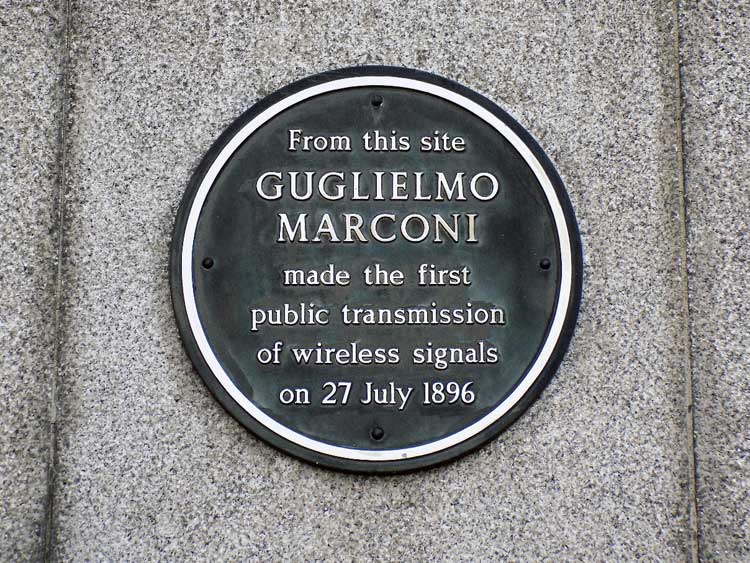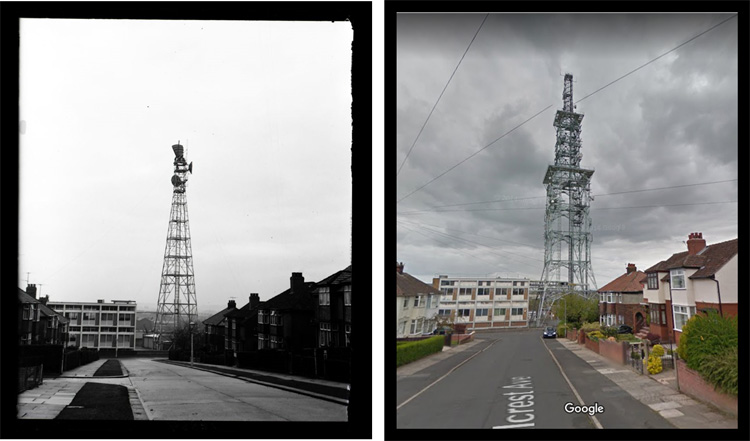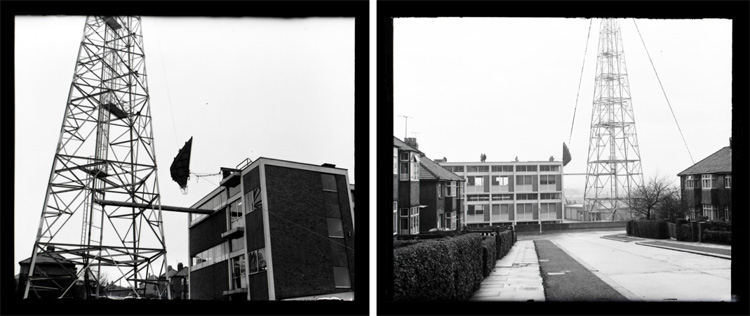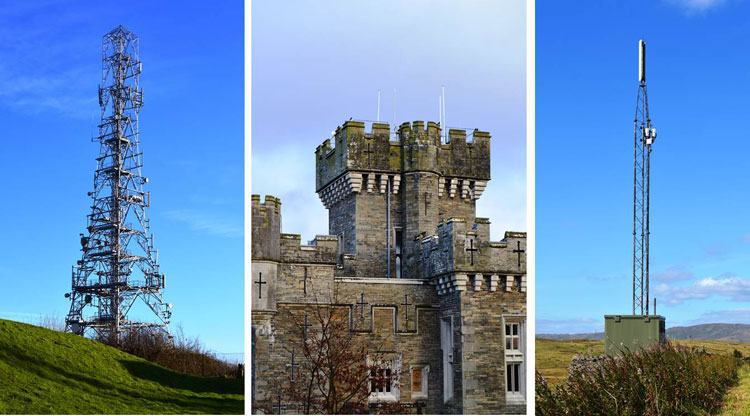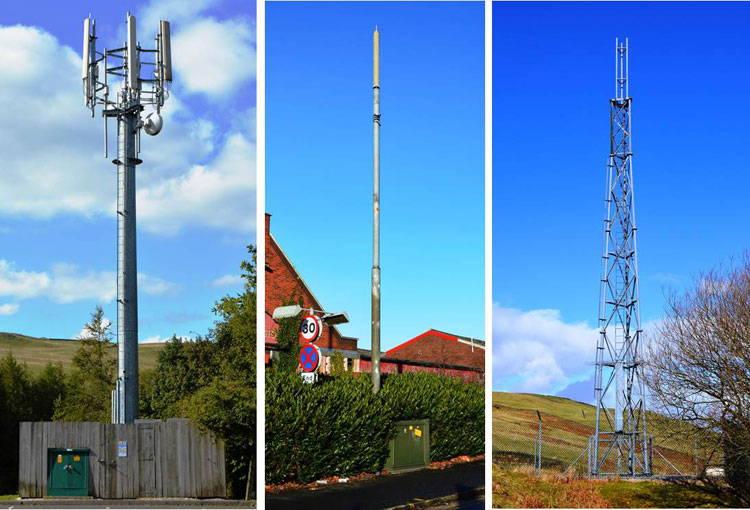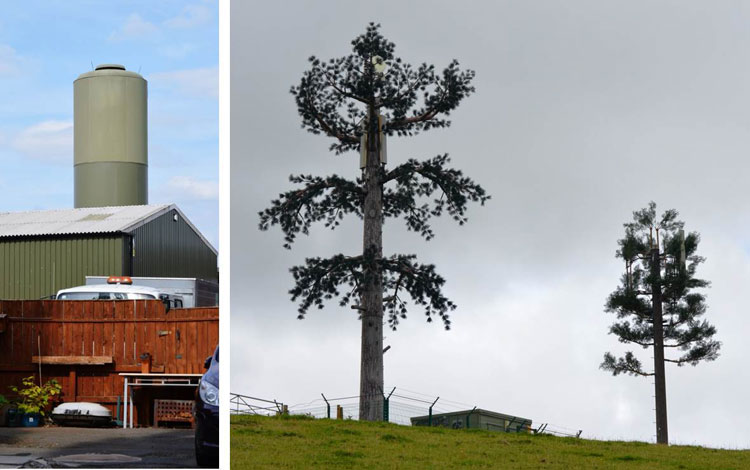Radio Towers and Masts – an important aspect of Industrial Archaeology
Andy Sutton and Nigel Linge, University of Salford
Introduction
Our lives today are more than ever before, reliant upon radio communications. Whether we are listening to a radio programme, watching television, making mobile phone calls, using WiFi to browse the web or following directions from a sat-nav, we are exploiting the convenience of wireless communication. However, the infrastructure which makes all of this possible is either hidden from view or simply ignored. With very few exceptions, telecommunications isn’t an industry populated by iconic structures. Whilst people are keen to admire, and seek to preserve, bridges, canals, railways and buildings, less enthusiasm is shown to do the same for, say, a mobile phone radio mast! Yet, given the impact that telecommunications has had, and continues to have, on society, surely there is a case that more should be done to record, appreciate and preserve the infrastructure of this important utility?
Thankfully Historic England has recognised this point and incorporated telecommunications within their research strategy however, little tangible evidence of it having been put into action can be seen. Maybe the problem is simply that telecommunications is too rapidly changing or still seen as a young industry? For example, the first mobile phone service opened in the UK in January 1985 and a mere 35 years later in 2020 we are destined to witness the launch of the fifth generation of mobile technology. In that short time, the radio masts which connect our phones have certainly grown in number but to the casual observer, probably look the same. Yet, this is simply not the case for as form follows function, the antennas which are attached to the various masts and the supporting equipment which sits at the bottom, have all evolved. In fact, none of the operational infrastructure which supported the first generation of analogue mobile phones in 1985 exists today. Meanwhile the mobile industry itself is so obsessed with today and tomorrow that little to no effort is being expended to record and preserve its past. This is not true for all branches of telecommunications. BT continue to maintain a world-class archive and there is a network of museums across the UK who have excellent galleries and exhibitions dedicated to telecommunications. Equally, the market for preserving traditional home telephones, radios, televisions and even mobile handsets is thriving. But what about the telecommunications infrastructure itself? We can all admire BT Tower in London or Arqiva’s Emley Moor tower in Yorkshire but what about the rest and indeed, the tens of thousands of mobile phone masts? Who cares about them?
Through this article we wish to raise the profile of the humble radio tower and mast and with that, stress their importance to the industrial heritage sector.
Broadcast Towers – Radio and Television
The discovery of radio in the 1800s, and specifically its onward development in the second half of the 19th nineteenth century, was turned into a practical form of communications by the Italian, Guglielmo Marconi. Having moved to England, where he believed the opportunities for commercial development were greater, Marconi delivered a series of demonstrations to the British Post Office in London during 1896, figure 1. Thereafter, he obtained permission from the French Government to erect a radio mast at Wimereux, near Boulogne and in 1899 successfully transmitted the first international wireless telegraph message between there and South Foreland Lighthouse in St Margaret’s Bay near Dover. As Marconi continued to develop the technology so radio’s potential for mass communications became apparent and this was realised on 11 May 1922 with the opening of the 2LO broadcast radio station in London and later 2ZY in Manchester. To reach as a many people as possible, it is essential to place radio transmitter antennas as high as possible so that signals avoid obstructions and buildings. Consequently, for 2LO, masts were erected on the roof of the Selfridges department store whereas for 2ZY the antenna was stretched from a water tower at the Metropolitan Vickers factory in Trafford Park.
Figure 1: Plaque on BT Centre, London, commemorating Marconi’s first demonstration of radio in the UK
Fourteen years later, television was introduced with the launch of the world’s first regular broadcast from Alexandra Palace in North London. That transmitter antenna was placed atop of a 215-foot tower which remains in service to this day and is preserved as an important piece of industrial archaeology.
Broadcast towers by their nature may be small in number but are some of the tallest structures in the country. Indeed, the tallest of all was once the tubular steel Belmont transmitter mast in Lincolnshire however, when it was shortened to 1,154 feet that honour transferred to the Skelton radio transmitter mast in Cumbria. Measuring 1,198 feet the Skelton transmitter is not in fact a public broadcast tower but is used by the Ministry of Defence for military communications. The Emley Moor transmitter in West Yorkshire, which is actually the third tower to occupy that site, holds the honour of being the tallest freestanding structure in the UK at a height of 1,084 feet. Made of reinforced concrete, it takes seven minutes by internal lift to reach the top, and has a total weight of 11,200 tonnes. As with all public broadcast transmitters, this site is now operated by Arqiva but is also listed by English Heritage because of its significant architectural and historic interest. And whilst not the tallest, the Winter Hill transmitter in Lancashire which was built in 1966, is the highest transmitter antenna in the country as measured from sea level!
In addition to the Skelton mast, there are a number of broadcast towers of importance and interest in Cumbria. Opened on 1 April 2007, the Anthorn Transmitter Station, took over from Rugby as the provider of the UK’s national time reference which is transmitted on 60kHz. If you have a radio-controlled clock at home, then it is receiving its signal from the atomic clocks and 745-foot transmitter mast located at Anthorn.
Measuring 1,106 feet, the Caldbeck guyed steel lattice mast is the third tallest structure in the UK and the main transmitter serving Northern Cumbria and South West Scotland. Originally built by the Independent Television Authority (ITA), the Caldbeck transmitter entered service on 1 September 1961 carrying the ITV 405-line analogue service. When television was upgraded to the 605-line system, Caldbeck was modified in 1971 to carry all three such channels, ITV, BBC1 and BBC2. However, the whole structure almost came to grief on 19 August 1977 when out of the heavy mist rolling across the Cumbrian Fells, a USAF F4 Phantom jet collided with the tower’s guide ropes slicing an 8 x 4-foot section off its wing and causing damage to the guide ropes. The aircraft recovered safely to a USAF airbase but the Caldbeck site had to be evacuated until a new guide rope could be installed. Interestingly, the tower which you can see today is not the original. In preparation for the Digital Switchover, Caldbeck underwent major engineering works to accommodate new transmitters and antennas. That in turn resulted in a new mast being erected in 2008 and the original dismantled.
Finally, the 502-foot Sandale transmitter originally carried BBC television before these were moved to Caldbeck. Today it is the main transmitter for FM and Digital radio services serving Cumbria and South West Scotland.
Network Towers – National Infrastructure
To deliver their services, telecommunications companies need a national network. Whilst today such networks use fibre optic cables, they were originally based on microwave radio. Developments in point to point microwave radio communications had progressed rapidly during the second world war and as such post-war activities started within the GPO for a national communications network which would move from concept to deployment during the 1950s and 60s.
The microwave radio band comprises frequencies from 3 GHz to 30 GHz however the popular use of the term tends to extend up to 42 GHz. Early systems tended to be in lower frequency bands with 4, 6 and 7.5 GHz being popular. A point to point radio system requires radio line of sight to allow the signals to travel between a transmitter and receiver which means that microwave radio installations are often positioned on tall communications towers. The distance between the towers is influenced by many considerations however it’s fair to say that to provide long-haul radio connectivity requires many radio relay stations with each receiving a signal on one radio link and retransmitting on another.
There were several key drivers for building a national network, often known as the backbone or trunk network, which included, cold war military communications, distribution of television content to local transmitters, and the evolution of the national telephone network. Cumbria was to play a key role in the national network with a repeater site built in Carlisle, figure 2. It became operational in 1961 probably initially to provide a link between the Border Television studios and the transmitter at Caldbeck. In subsequent years the site expanded significantly as part of the main west coast trunk route and as a television switching centre.
BT Archives contain a number of photos, figure 3, showing the installation of an 8-foot horn antenna on the then 175-foot tower during 1961. Interior photographs from 1967 show equipment for routes to Belfast, Pontop Pike, Manchester and Kirk o’Shotts – suggesting that the site achieved full connectivity around this period. Other photos show a new “standard tower” being constructed – enclosing the old structure – and the arrival of large microwave horn antennas.
It is likely the BBC television station at Sandale Fell was fed via Carlisle once the site became a switching centre, however we understand that initially the routing was via Pontop Pike and then direct from Hope Alone, with Sandale becoming operational by November 1956.
The site is adjacent to the telephone exchange on Hillcrest Avenue which appears on OS maps in the 1960s with the “mast” having an increased cross-section between 1964 and 1967 editions. A 1957 map shows a much smaller building on part of the site, suggesting the exchange was extended in the early 1960s, perhaps as part of the plans for the Radio Station. Google Street View shows two different styles of building along Hillcrest Avenue and in 2009 the mast carried large dish antennas which faced Riddings Hill, but these have since been removed.
Figure 2: Carlisle radio site – left image from 1961, right image from Google street view, 2017 (Source: BT Archives, Google Street View)
Figure 3: Horn antennas being installed at Carlisle radio site in 1961 (Source: BT Archives)
Whilst all of this was happening in Cumbria, what’s possibly the most famous radio tower in the UK was being built approximately 300 miles away in London. Work commenced on the Post Office tower as it was originally known, now BT Tower, in 1961 and completed, with the official opening on 8th October 1965. This icon of the London skyline formed part of the same national microwave radio network as the Carlisle radio site and like Carlisle has seen many changes over the years with its own horn antennas having also been removed.
It’s not just BT who relied on microwave radio connections to and via Cumbria. In 1981 Mercury Communications was formed as a subsidiary of Cable and Wireless to challenge BT in the provision of national telecommunications services. Mercury communications established a national network based on Siemens 140Mbps (Mega Bits Per Second) microwave radio equipment. The system required several relays in Cumbria, these were known as Scout Hill radio site and Grey Rigg radio site. These two locations enabled connectivity from Manchester to Scotland and also provided services for customers in the area.
The invention of fibre optic cable and suitable laser based transmission systems was the beginning of the end for long-haul trunk microwave radio systems. As capacity demands grew the somewhat limited capacity of microwave radio became a constraining factor in the expansion of network services. Optical fibre based transmission systems started to be rolled out in significant volumes during the 1980s and have continued at a rapid rate ever since. The installation of fibre cables is expensive and time consuming however through the 80s and 90s such significant volume was installed that many trunk microwave systems in use with BT, Mercury communications and others, became redundant. However, due to the ease of installation and overall lower cost versus digging optical fibre cable ducts, microwave can still be found in some limited trunk applications and also for providing connectivity for mobile phone base stations.
Mobile phone masts
The UKs first commercial cellular mobile phone network was launched by Vodafone on the 1st January 1985 becoming the first of five national networks which would be built during the following years. Unlike broadcast or microwave towers, mobile relies on a network comprising thousands of inter-linked radio base stations, each providing short range communications to your mobile phone within what is termed a cell, hence, cellular.
The speed at which these base stations or cells were deployed was quite remarkable; at the peak there were over 54,000 operational sites in the UK. In just 30 years the physical form of a cellular radio site has changed significantly, quite often this goes unnoticed as the radio tower, column or rooftop installation is still there and appears unchanged. Yet, the evolution from first generation (1G) to 2G, 3G and now 4G has changed the radio antennas and site equipment considerably. The number of cell sites has actually reduced recently because of mergers (Orange and T-Mobile formed EE) and as mobile network operators are increasingly sharing infrastructure. That in turn means that a large number of cellular radio sites have been decommissioned and in some cases, completely removed from the landscape. In other cases, they are left in situ but with no communications equipment installed.
The actual structures on which the antenna system is mounted vary considerably and for a range of reasons; from planning permission to site provider requirements and from radio planning considerations to structural loading. Structures can be classed as rooftops, masts, towers, columns, street-works (lampposts) and many other things, including some disguised as trees.
Figure 4 illustrates a few of the diverse range of structures in use for the provision of cellular radio signals; on the left is a pre-cellular microwave radio tower which formed part of BT’s national microwave radio based telecommunications trunk transmission network. This structure itself is worthy of detailed study as its form has altered considerably with its change of function over the last few decades. The rooftop in the centre is Wray Castle, a National Trust property and former telecommunications training college on the shore of Lake Windermere. Four slim vertical cellular antennas can be seen on the top of the building. Two of these belong to EE (previously Orange) and two belong to Vodafone. The tower to the right illustrates how antenna system evolution changes the required form in line with a different function. Rather than a wide tower to provide wat is termed space diversity to improve the reception of signals, an alternative technique known as polarisation diversity is employed; this removes the need for the spatial separation of antennas and therefore allows for narrower structures which have less visual impact on the local environment. This particular tower is a Vodafone site which can be found Just north of M6 J37 (Southbound side).
Figure 4: Mobile phone cell site installations on towers and rooftop
Figure 5 highlights a range of alternative structures used to support cellular antenna systems. A circular dish-like antenna can be seen just below the long cellular antennas on the column on the left; this is a point to point digital microwave radio system which provides the connection between the cell site and the mobile operator’s national network, from where the call or data session is onwards connected. This column is an EE site with both EE and Vodafone antennas installed (site sharing) and is located at Killington Lake Services (M6 Southbound). The column in the middle and slim-line lattice tower on the right are both further examples of the typology of cellular radio sites and yet, also examples of sites which have been decommissioned due to the trend towards greater network sharing between operators. The column in the middle is a former T-Mobile installation photographed shortly before it was removed completely. The tower on the right is an example of a site installation after decommissioning in which the tower remains however, all antennas and associated equipment have been removed. Maybe in this latter case the site provider has chosen to keep the compound and tower in anticipation of future commercial opportunities?
Figure 5: Column, pole and slim-line lattice tower
In addition to the obvious roof tops, towers, columns and poles, there’s a wide range of less than obvious cellular installations in the UK. Figure 6 highlights two examples. The image on the left looks like a farm silo however in reality it’s a cellular radio tower covered with a structure which allows radio frequencies to pass through with very little loss, therefore enabling an installation which is sympathetic with its surroundings. The fake trees on the right belong to two different operators who have deployed on the same hill top. A wide variety of fake tree structures have been deployed across the UK, often in areas of outstanding natural beauty in an attempt to minimise the visual impact while providing the necessary mobile phone coverage. Both types of installation shown here are used in Cumbria however these particular examples are from Cheshire and Lancashire respectively.
Figure 6: Fake farm silo and trees
Conclusion
In this article we have raised the profile of the humble telecommunications radio tower and mast from the point of view of their importance for radio and television broadcasting, as part of the national infrastructure and in providing mobile phone services. Many aspects of people’s everyday lives are dependent on these towers yet, their significance or indeed, their existence, is generally ignored or taken for granted. From an industrial heritage point of view, telecommunications is not well covered, especially the more recent developments in mobile communication despite its obvious massive impact on society. In that respect, telecommunications has become a hidden utility, with what attention it does receive being focused on the user equipment (e.g. vintage televisions, old mobile phones) rather than the infrastructure that makes it all work. The mobile industry especially is poorly recorded, often being considered as something quite new and therefore not yet warranting preservation. However, as we have shown, in its short life mobile has evolved through four generations of technology, with a fifth about to appear. This means that we have already lost a significant amount of heritage. Not a single first generation cellular site installation remains in existence in the UK, although some base station equipment is on display within the Information Age gallery at the Science Museum in London. Similarly, there is a serious lack of photographic and documented evidence of this period, a period on which our future connected society is being built.
We therefore hope that in reading this article, we have opened your eyes to what we feel is an important but seriously under represented aspect of industrial archaeology.
Bibliography
- Overview of BTs national microwave radio trunk transmission network
- 30 Years of Mobile Phones in the UK, Amberley Publishing
- Mobile Network Evolution within the UK (available at: http://www.engagingwithcommunications.com/publications/ITP_Papers/Mobile_network_evolution/ITP_Journal_Mobile_Network_Evolution_within_the_UK.html)
- The heritage of 30 years of mobile communications in the UK (Industrial Archaeology Review, Vol 38, May 2016)
- A number of relevant, local images, can be found in the BT digital archives accessible from: http://www.digitalarchives.bt.com/Calmview/ (Search for photographs and Carlisle in the advanced search option)
(Page created 07/11/22)

